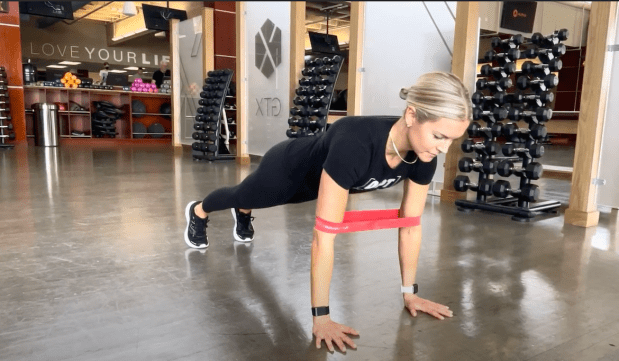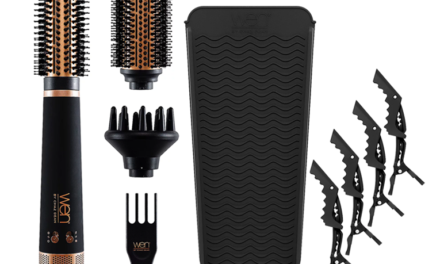Time is ticking.
Despite how simple they look, push-ups can be an intimidating exercise as they require total-body strength, from leg stabilization to core engagement to upper-body endurance.
In fact, push-ups may be linked to living longer and having better cardiovascular health, according to a 2019 study in JAMA Network Open. Active, middle-aged men who were able to do more than 40 push-ups had a significantly lower risk of heart disease during 10 years of follow-ups compared to those who were unable to do more than 10 push-ups during the baseline test.
It is worth noting, however, that this study was only done in men, and we don’t necessarily know if someone’s ability to do push-ups is the only reason they did or did not get heart disease. That said, push-ups still offer many benefits—like building muscle and bone strength and improving heart health—so it’s worth adding them into your workout sessions.
Going from no push-up experience to cranking out 40 push-ups would be a difficult task for anyone, so start your push-up journey with some help from a staple of any home or commercial gym—a looped mini band or a resistance band—and follow this trick to make push-ups easier but still effective.
How to use a resistance band to make push-ups easier
Lindsay Ogden, CPT, certified personal trainer and master trainer at Life Time in Eden Prairie, Minnesota, is well-versed in helping people at all stages of their wellness journeys adapt movements like push-ups to be accessible while still providing a workout.
Follow these steps to nail this push-up modification:
- Start in tabletop position with a mini band of your desired resistance looped around your arms, just above your elbows. Your hands should be under shoulders and your knees should be under your hips.
- Step your feet back and straighten your legs so you’re balanced on your hands and toes. Your body should be in a straight line from your head to your heels and your hands should be directly under your shoulders.
- Bend your elbows at a 45-degree angle to your body and lower your body to the floor, bracing against the mini band and using the middle part of the mini band to support your diaphragm area to prevent a sinking chest.
- Press into your palms and push the floor away from you to come back up to a high plank, using the resistance from the band as a brace for your arms, helping to propel you upward while maintaining good form.
- Repeat.
“Push-ups can be intimidating, that’s for sure. This is why it’s good to know how to modify a standard, unassisted push-up. You’ll feel empowered to build your strength via a modification and create confidence in your ability to complete the push-up movement correctly with or without a mini band.” —Lindsay Ogden, CPT
The benefits of doing a modified push-up with a mini band
Push-ups can seem inaccessible at first, especially if upper-body strength is not your strong suit. Modified push-ups offer a good starting point for advancing to unassisted push-ups, and they also help with injury prevention and understanding the basic elements of correct push-up form.
Let’s dive deeper into the benefits of doing a push-up using a mini band.
1. It assists the toughest part of the push-up
This mini-band trick helps you where you need it most: at the bottom of a push-up when your body is close to the floor.
“Ideally, we’re getting full range of motion when we do push-ups, with our chest touching the floor. But that position—with our chest close to the floor—is also the toughest part of the push-up to move out of,” Ogden says. “With the mini band being the most taut or stretched at the bottom of the push-up, it can help ‘spring’ you back up to the top of the push-up, making it a bit easier on the upper body and core.”
2. It helps promote good push-up form
Many of us have tried doing push-ups, only to find that our backs arch or sink toward the floor, our elbows flare out, or our hands sit too wide for an effective push-up. Doing a few push-ups with subpar form may not be harmful, but making a habit of it could cause injury or long term pain.
Using a mini band can help promote correct push-up form, Ogden says. So even if you’re a push-up veteran, it may not be a bad idea to revisit this trick every so often.
“A common mistake I see with push-ups is elbows that flare outward, away from the body, when the elbows should be at a 45- degree angle as one lowers towards the ground,” Ogden says. “The mini band helps keep the elbows close to the body and give your arms something to brace against during the push-up movement. This also helps target the triceps, which is a key muscle to strengthen as you build towards unassisted push-ups.”
3. It improves push-up confidence
Fear of injury or judgment from others can hold us back from progressing at push-ups, but the mini band push-up trick can improve confidence with this difficult exercise.
“Push-ups can be intimidating, that’s for sure,” Ogden says. “This is why it’s good to know how to modify a standard, unassisted push-up. You’ll feel empowered to build your strength via a modification and create confidence in your ability to complete the push-up movement correctly with or without a mini band.”
How to choose the correct mini band resistance level for you
Mini bands and resistance bands come in a variety of resistance levels, and brands often color code their bands based on how difficult a band is to stretch.
While it may be enticing to go straight to the hardest resistance level to try to maximize your push-up workout, this is not a smart idea. Using a resistance level that is too easy or too hard can cause improper form, ineffective push-ups, and even injury.
The thicker the band, the more resistance it has, and will provide more support during a push-up, Ogden says. But a thicker band will also make it more difficult to keep your arms in the proper position, which is flush against the sides of your body as you move through the push-up.
“If you struggle to stretch the band enough to even put it on your biceps without rolling the band up your arms or pulling your arms inward and unnaturally narrow, then I’d say the band is too tight for you,” Ogden says.
On the flip side, if the band is too loose or doesn’t provide enough resistance, you won’t maximize this push-up trick because the mini band won’t provide enough assistance to help “spring” you back up and keep your arms in the correct position as you press upwards off the floor, Ogden says.
Choosing a band that is easy to get on and keep on your biceps with your arms shoulder-width apart in plank position and provides just enough assistance to offset the difficulty of pressing off the floor is a good place to start in terms of which resistance level you should choose.
How to progress to a standard push-up
Before even attempting to use the mini band push-up trick, Ogden likes to start her clients’ push-up journeys by doing incline push-ups, where the front of the body is elevated to decrease the distance you need to drop down to.
“I like to use something like a Smith machine or adjustable barbell for clients who are learning how to do push-ups,” Ogden says. “This decreases the stress on their shoulders and wrists and also decreases the distance a client needs to drop down to and push up from while still working on the correct foundational plank form for a push-up.”
As the heights of the barbell or elevated surface become too easy, you can progress to less-elevated surfaces. Ogden says she likes to see clients do at least three unassisted push-ups before adding in any bands or further modifications to ensure clients understand which muscles to engage as they move down and up through the motion and how to maintain proper push-up form.
“Once a client is able to hold and push their own weight for at least three push-ups, I consider adding in bands for resistance,” Ogden says. “You can also add in further modifications like eccentric push-ups, where you lower down to the ground over three to five seconds and then explode upward, all while maintaining proper push-up form.”
Ogden says she’s not a fan of doing push-ups on your knees—barring unique individual circumstances—because you remove too much of your body weight to truly benefit from the push-up, and it takes away from learning ideal push-up form.
Be sure to chat with a certified personal trainer or coach to understand which modifications and progressions are right for you.
The best mini bands to assist your push-ups
There are more mini bands on the market than you could likely ever test. While there are some cheap sets of mini bands on websites like Amazon, it’s generally best to stick to name brands.
Cheaper mini bands may be made of low-quality materials, which means they could wear out and provide inaccurate resistance levels or spontaneously break if put under too much resistance.
Instead, Ogden suggests investing in mini band sets from respected brands. She recommends TRX, Rogue and SPRI mini bands due to those brands’ decades of good reviews and presence in commercial gyms nationwide, which means they can withstand consistent usage without failure.
Recommended Story For You :

The alpine secret for healthy weight loss

The Most Potent Fast-Acting Formula For Incinerating Stubborn Fat

Real Cortexi Users Real Life‑Changing Results

This Cold Drink Might Trigger Your Prostate

Red Boost is a powerful new formula for boosting male sexual health.

Everything you eat or drink eventually reaches your liver for processing.

Brand New Probiotics Specially Designed For The Health Of Your Teeth And Gums

Empowering You to Take Control of Your Blood Sugar Health!

Scientists Finally Discover the Root Cause of Belly Fat and Unexplained Weight Gain






